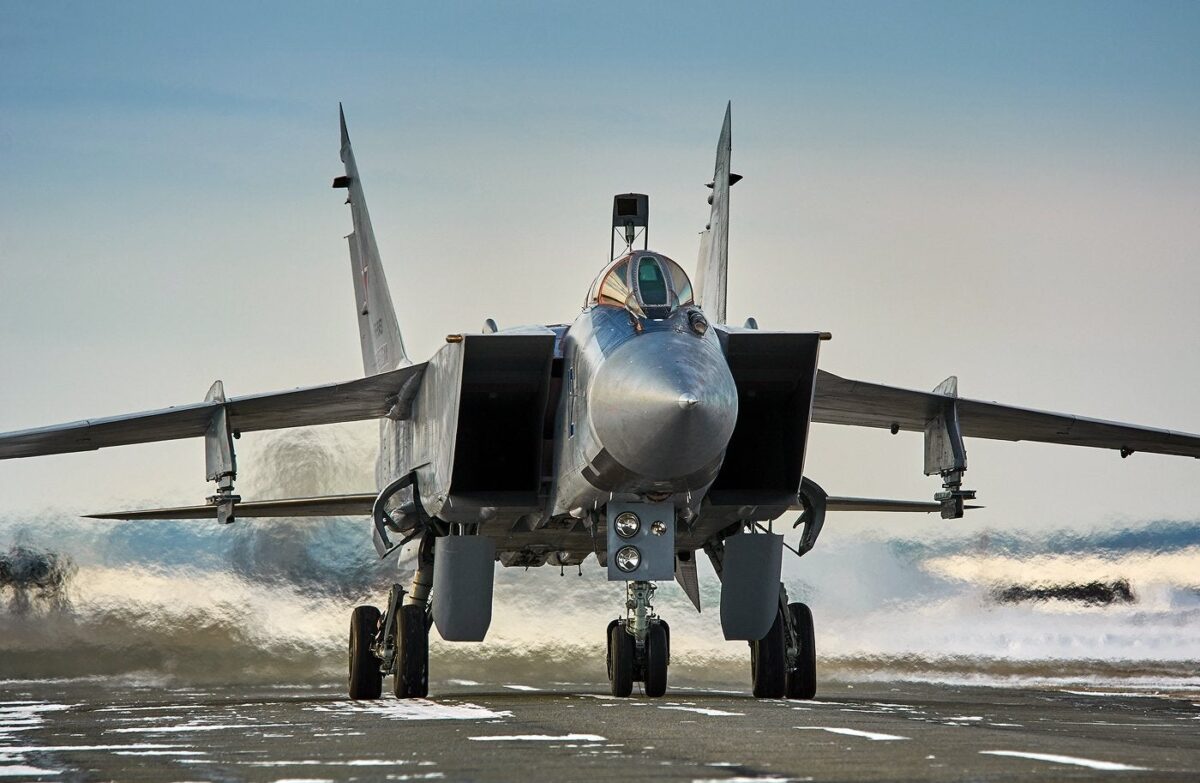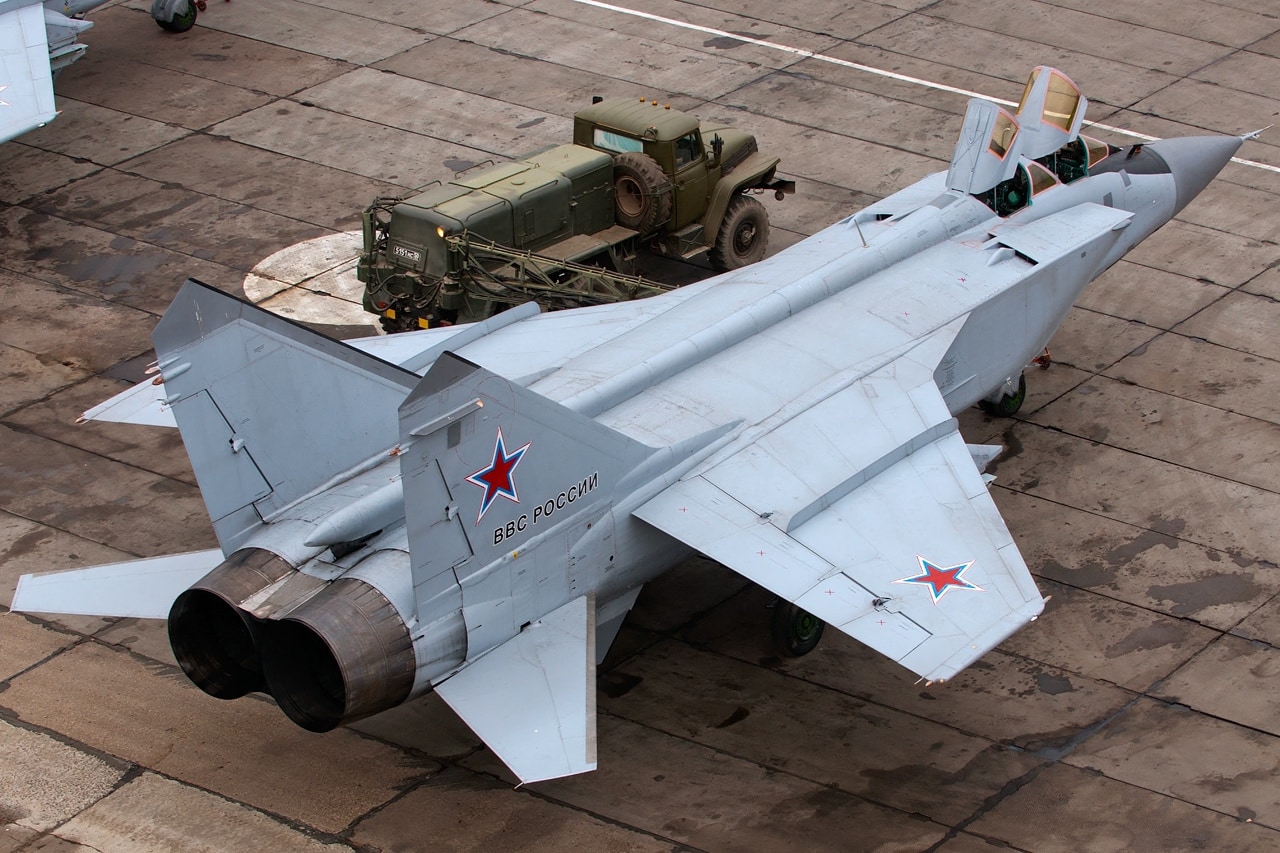After all the embarrassing setbacks Vladimir Putin has suffered in Russia’s “special military operation” in Ukraine – in the air, on the land, and on the sea alike – he can now bask in at least one minor tactical and propaganda victory: evidently, a Russian MiG-31 jet fighter managed to successfully intercept a Ukrainian Su-24 attack aircraft. So then, what exactly do we know about these two airframes and the actual incident itself? Let’s take a deeper dive.

Image Credit: Creative Commons.
MiG-31 “Foxhound” History and Technical Specifications
The Mikoyan-Gurevich MiG-31 (NATO reporting name: “Foxhound”) is a direct successor to the MiG-25 Foxbat, which in turn was – and still is – the fastest interceptor in the world. As noted in a previous 19FortyFive article on the Foxhound back in June:
“The Foxhound made her maiden flight in September 1975 and officially entered into service with the Soviet PVO (voyska protivovozdushnoy oborony, or Anti-Air Defense Troops) in 1981 … The MiG-31 bears a striking cosmetic resemblance to the MiG-25, which probably explains at least in part why NATO retained the ‘Fox’ portion when assigning its codename to the successor aircraft. However, look beneath the surface and you will find the Foxhound equipped with state-of-the-art digital avionics that its older foxy sibling lacked … For one thing, the MiG-31 was the first Soviet fighter aircraft to have true look-down/shoot-down capability, thanks to its phased array radar. Earlier USSR fighter radars had a tendency to run afoul of ground clutter. In addition, the Foxhound can work efficiently in all weather conditions while fulfilling visual flight rules and instrument flight rules, day and night.”
The MiG-31 has a two-person crew, consisting of the pilot and weapon system officer (WSO). The plane has a fuselage length of 21.6 meters (70 feet 10 inches), a wingspan of 13.45m (44 feet 1 inch), and a height of 6.45 meters (21 feet 1 inch), with an empty weight of 21,825 kilograms (48,511 pounds) and a maximum takeoff weight of 46,200 kilograms (101,853 pounds). Max airspeed is Mach 2.83 (1,234.8 kph/2,154 mph). Armament consists of 1× GSh-6-23 23 mm cannon with 260 rounds; fuselage recesses for 4× R-33 (AA-9 ‘Amos’) (or for MiG-31M/BM only 6× R-37 [AA-X-13 ‘Arrow’] long-range air-to-air missiles); 4 underwing pylons for a combination of 2× R-40TD1 (AA-6 ‘Acrid’) medium-range missiles,4× R-60 (AA-8 ‘Aphid’), 4× R-73 (AA-11 ‘Archer’) short-range IR missiles, and 4× R-77 (AA-12 ‘Adder’) medium-range missiles.
519 Foxhounds were built between 1975 and 1994.
Sukhoi Su-24 “Fencer” History and Technical Specifications
The Sukhoi Su-24 (NATO reporting name: “Fencer”) is a long-range, low-level all-weather attack aircraft, roughly analogous to the British-German-Italian Panavia Tornado IDS. She made her maiden flight in May 1970 and entered frontline service in 1973, first being “blooded” in combat in 1984 during the Soviet-Afghan War. The Fencer was the replacement for the Yakovlev Yak-28, which in turn was manufactured from 1958 to 1968. The plane features a variable geometry swing wing and a side-by-side cockpit, which hosts the 2-person crew of pilot and WSO.
The fuselage length is 22.59 meters (74 feet 1 inch), with a wingspan of 17.64 meters (57 feet 10 inches) whilst spread, 10.37 meters (34 feet) in swept mode, and a height of 6.19 meters (20 feet 3 inches). Empty weight is 22.3 tons and the max takeoff weight is 36 tons. Max airspeed is Mach 1.0776 (1,320 kph/820.21 mph). Armament consists of: one 23mm cannon; Kh-23, Kh-25ML, Kh-29L/T, Kh-59 and Kh-59M air-to-surface missiles; Kh-25MP, Kh-31P, Kh-29MP and Kh-58 anti-radar missiles; Kh-31A, Kh-35 anti-ship missiles, R-60 air-to-air missiles; KAB-500Kr laser-guided bombs; and for Doomsday scenarios, TN-1000 and TN-1200 free-fall nuclear weapons. However, Ukraine does not have access to such armaments.
Roughly 1,400 Su-24s were built between 1967 and 1993.
The Intercept Incident Itself
A November 1, 2022 report by Frank Johnson for the International Military news website provides this insight on the incident:
“According to the [Russian Ministry of Defense], the MiG-31 aircraft were assigned to air patrols in the mandated area. The crew then detected an aerial target during one of its flights … After confirming that the target was an enemy aircraft, the crew launched air-to-air missiles to intercept the Ukrainian Su-24. Without specifying the date and location of the incident, the ministry released a video showing the crew of the MiG-31 preparing for the mission and taking off carrying two RVV-BD missiles with a firing range of 300 km under the fuselage and two RVV-SD missiles with a maximum firing range of 110 km. under the wing posts … If the aircraft shown in the video is an aircraft involved in combat, then it can be assumed that the MiG-31 shot down the Su-24 using an RVV-SD missile.”
At press time, the Ukrainian Government has yet to acknowledge the incident one way or the other, i.e. whether to confirm or deny the loss.
Christian D. Orr is a former Air Force Security Forces officer, Federal law enforcement officer, and private military contractor (with assignments worked in Iraq, the United Arab Emirates, Kosovo, Japan, Germany, and the Pentagon). Chris holds a B.A. in International Relations from the University of Southern California (USC) and an M.A. in Intelligence Studies (concentration in Terrorism Studies) from American Military University (AMU). He has also been published in The Daily Torch and The Journal of Intelligence and Cyber Security. Last but not least, he is a Companion of the Order of the Naval Order of the United States (NOUS). In his spare time, he enjoys shooting, dining out, cigars, Irish and British pubs, travel, USC Trojans college football, and Washington DC professional sports.
Want More 19FortyFive articles, news, and analysis on the top military, defense, national security, as well as politics and economics news? Make sure to follow us on Google News, Flipboard, YouTube, Facebook, Twitter, and Linkedin. Also, please don’t forget to sign up for our newsletter here. You can also find our code of publishing ethics and standards here.

